How to calculate ventilation: formulas and an example of calculating a supply and exhaust system
Do you dream of having a healthy microclimate in your home and not a single room smelling musty and damp? In order for the house to be truly comfortable, it is necessary to carry out proper ventilation calculations even at the design stage.
If this important point is missed during the construction of a house, you will have to solve a number of problems in the future: from removing mold in the bathroom to new renovations and installing an air duct system. Agree, it’s not very pleasant to see breeding grounds for black mold in the kitchen on the window sill or in the corners of the children’s room, and to plunge into renovation work all over again.
The article we presented contains useful materials on the calculation of ventilation systems and reference tables. Formulas, visual illustrations and a real example for premises of various purposes and a certain area, demonstrated in the video, are provided.
The content of the article:
Causes of ventilation problems
With correct calculations and proper installation, the ventilation of the house is carried out in a suitable mode. This means that the air in living areas will be fresh, with normal humidity and without unpleasant odors.
If the opposite picture is observed, for example, constant stuffiness, mold in the bathroom or other negative phenomena, then you need to check the condition of the ventilation system.
A lot of problems are caused by the absence of the thinnest gaps characteristic of windows and doors, caused by the installation of sealed plastic structures. In this case, too little fresh air enters the house; you need to take care of its flow.
Blockages and depressurization of air ducts can cause serious problems with the removal of exhaust air, which is saturated with unpleasant odors, as well as excess water vapor.
As a result, fungal colonies may appear in office premises, which is bad for people’s health and can cause a number of serious diseases.
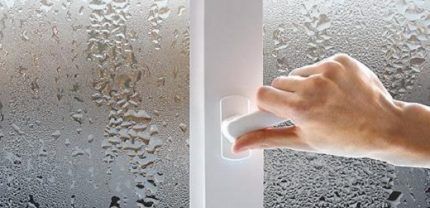
But it also happens that the elements ventilation system work great, but the problems described above remain unresolved. Perhaps the calculations of the ventilation system for a particular house or apartment were carried out incorrectly.
The ventilation of rooms can be negatively affected by their alteration, redevelopment, appearance of extensions, installation of the previously mentioned plastic windows, etc. With such significant changes, it is not possible to re-calculate and upgrade the existing ventilation system in accordance with the new data.
One easy way to detect ventilation problems is checking for traction. You need to bring a lit match or a sheet of thin paper to the exhaust grille. You should not use open fire for such a check if gas heating equipment is used in the room.
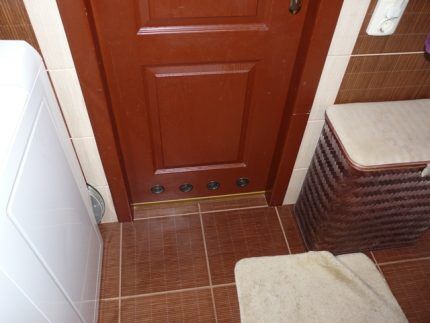
If the flame or paper confidently deviates towards the exhaust, there is draft, but if this does not happen or the deviation is weak, irregular, the problem with exhaust air removal becomes obvious.The cause may be blockages or damage to the air duct as a result of inept repairs.
It is not always possible to eliminate the breakdown; the solution to the problem is often the installation of additional exhaust ventilation means. Before installing them, it also wouldn’t hurt to carry out the necessary calculations.
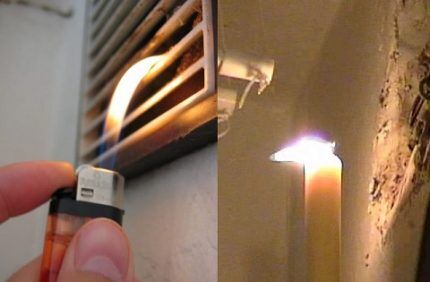
How to calculate air exchange?
All calculations for ventilation systems come down to determining the volume of air in the room. Such a room can be considered either a separate room or a collection of rooms in a particular house or apartment.
Based on these data, as well as information from regulatory documents, the main parameters of the ventilation system are calculated, such as the number and cross-section of air ducts, fan power, etc.
There are specialized calculation methods that allow you to calculate not only the renewal of air masses in a room, but also the removal of thermal energy, changes in humidity, removal of contaminants, etc. Such calculations are usually performed for industrial, social or any specialized buildings.
If there is a need or desire to perform such detailed calculations, it is best to contact an engineer who has studied such techniques.
For independent calculations for residential premises, use the following options:
- by multiples;
- according to sanitary and hygienic standards;
- by area.
All these methods are relatively simple; once they understand their essence, even a non-specialist can calculate the basic parameters of their ventilation system. The easiest way is to use area calculations.The following norm is taken as a basis: every hour three cubic meters of fresh air per square meter of area should enter the house.
The number of people who permanently live in the house is not taken into account.
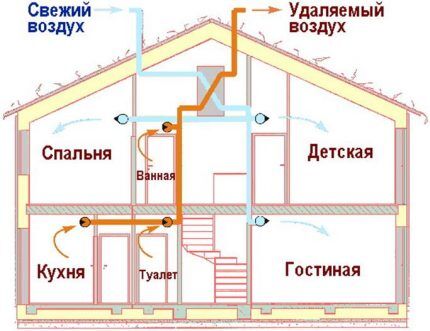
Calculation according to sanitary and hygienic standards is also relatively simple. In this case, for calculations, it is not the area that is used, but data on the number of permanent and temporary residents.
For each permanent resident it is necessary to provide an influx of fresh air in the amount of 60 cubic meters per hour. If temporary visitors are regularly present in the room, then for each such person you need to add another 20 cubic meters per hour.
The calculation based on the air exchange rate is somewhat more complicated. When performing it, the purpose of each individual room and the standards for the frequency of air exchange for each of them are taken into account.
The air exchange rate is a coefficient that reflects the amount of complete replacement of exhaust air in a room within one hour. The relevant information is contained in a special regulatory table (SNiP 2.08.01-89* Residential buildings, adj. 4).
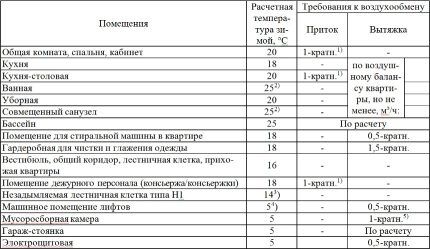
You can calculate the amount of air that must be renewed within an hour using the formula:
L=N*V,
Where:
- N — air exchange rate per hour, taken from the table;
- V – volume of the room, cubic meters.
The volume of each room is very easy to calculate; to do this, you need to multiply the area of the room by its height. Then, for each room, the volume of air exchange per hour is calculated using the above formula.
The L indicator for each room is summed up, the final value allows you to get an idea of exactly how much fresh air should enter the room per unit of time.
Of course, through exhaust ducts Exactly the same amount of exhaust air must be removed. Both supply and exhaust ventilation are not installed in the same room. Typically, air flow is carried out through “clean” rooms: bedroom, nursery, living room, office, etc.
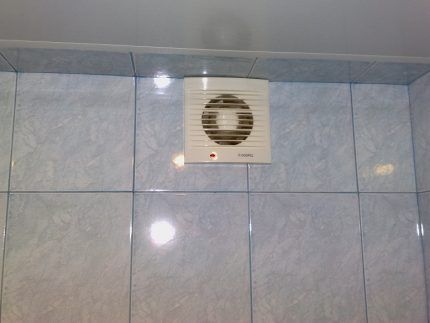
They remove air from rooms for service purposes: bathrooms, bathrooms, kitchens, etc. This is reasonable, since the unpleasant odors characteristic of these rooms do not spread throughout the home, but are immediately removed outside, which makes living in the house more comfortable.
Therefore, when making calculations, they take the standard only for supply or only for exhaust ventilation, as reflected in the standard table.
If air does not need to be supplied to or removed from a specific room, there is a dash in the corresponding column. For some rooms, a minimum air exchange rate is specified. If the calculated value is below the minimum, the tabulated value should be used for calculations.
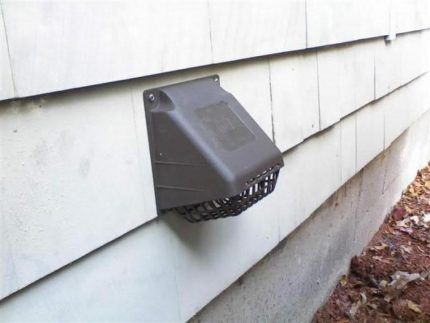
Of course, there may be rooms in the house whose purpose is not shown in the table.In such cases, the standards adopted for residential premises are used, i.e. 3 cubic meters for every square meter of room. You just need to multiply the area of the room by 3, and take the resulting value as the standard air exchange rate.
All values of the air exchange rate L should be rounded upward so that they are multiples of five. Now you need to calculate the sum of the air exchange rate L for the rooms through which air flows. The air exchange rate L of those rooms from which exhaust air is removed is separately summed up.
If the calculation result does not meet sanitary requirements, installation is carried out supply valve,breather or hoods through the wall, the existing system is being upgraded or cleaned.
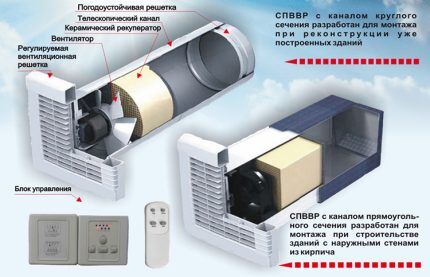
Then you should compare these two indicators. If L for inflow turned out to be higher than L for exhaust, then it is necessary to increase the indicators for those rooms for which minimum values were used in the calculations.
Examples of air exchange volume calculations
To carry out the calculation for ventilation system in multiples, first you need to make a list of all the rooms in the house, write down their area and ceiling height.
For example, a hypothetical house has the following rooms:
- Bedroom - 27 sq.m.;
- Living room - 38 sq.m.;
- Office - 18 sq.m.;
- Children's room - 12 sq.m.;
- Kitchen - 20 sq.m.;
- Bathroom - 3 sq.m.;
- Bathroom - 4 sq.m.;
- Corridor - 8 sq.m.
Considering that the ceiling height in all rooms is three meters, we calculate the corresponding air volumes:
- Bedroom - 81 cubic meters;
- Living room - 114 cubic meters;
- Cabinet - 54 cubic meters;
- Children's room - 36 cubic meters;
- Kitchen - 60 cubic meters;
- Bathroom - 9 cubic meters;
- Bathroom - 12 cubic meters;
- Corridor - 24 cubic meters.
Now, using the table above, you need to calculate the ventilation of the room, taking into account the air exchange rate, increasing each indicator to a multiple of five:
- Bedroom - 81 cubic meters * 1 = 85 cubic meters;
- Living room - 38 sq.m.*3 = 115 cubic meters;
- Cabinet - 54 cubic meters * 1 = 55 cubic meters;
- Children's room - 36 cubic meters * 1 = 40 cubic meters;
- Kitchen - 60 cubic meters. — not less than 90 cubic meters;
- Bathroom - 9 cubic meters. not less than 50 cubic meters;
- Bathroom - 12 cubic meters. not less than 25 cubic meters
There is no information about the standards for the corridor in the table, so the data for this small room is not taken into account in the calculation. For the living room, a calculation of the area was carried out taking into account the standard of three cubic meters. meters for every meter of area.

Now you need to separately summarize the information on the rooms in which air flows, and separately on the rooms where exhaust ventilation devices are installed.
Air exchange volume by inflow:
- Bedroom - 81 cubic meters*1 = 85 cubic meters/hour;
- Living room - 38 sq.m.*3 = 115 cubic meters/hour;
- Cabinet - 54 cubic meters*1 = 55 cubic meters/hour;
- Children's room - 36 cubic meters * 1 = 40 cubic meters/hour;
Total: 295 cubic meters per hour.
Exhaust air exchange volume:
- Kitchen - 60 cubic meters. — not less than 90 cubic meters/h;
- Bathroom - 9 cubic meters. — not less than 50 cubic meters/h;
- Bathroom - 12 cubic meters. — not less than 25 cubic meters/hour.
Total: 165 cubic meters/h.
Now you should compare the amounts received. It is obvious that the required inflow exceeds the exhaust by 130 cubic meters per hour (295 cubic meters per hour - 165 cubic meters per hour).
To eliminate this difference, you need to increase the volume of air exchange through the hood, for example, by increasing the indicators in the kitchen. In practice, this is done, for example, by replacing air ducts with channels of a larger cross-section.
Rules for calculating the area of air ducts for replacing or upgrading the ventilation system are given here. We recommend that you read the useful material.
After the edits, the calculation results will look like this:
Air exchange volume by inflow:
- Bedroom - 81 cubic meters*1 = 85 cubic meters/hour;
- Living room - 38 sq.m.*3 = 115 cubic meters/hour;
- Cabinet - 54 cubic meters*1 = 55 cubic meters/hour;
- Children's room - 36 cubic meters * 1 = 40 cubic meters/hour;
Total: 295 cubic meters per hour.
Exhaust air exchange volume:
- Kitchen - 60 cubic meters. — 220 cubic meters/h;
- Bathroom - 9 cubic meters. — not less than 50 cubic meters/h;
- Bathroom - 12 cubic meters. — not less than 25 cubic meters/hour.
Total: 295 cubic meters/h.
The inlet and outlet volumes are equal, which meets the requirements when calculating air exchange by multiplicity.
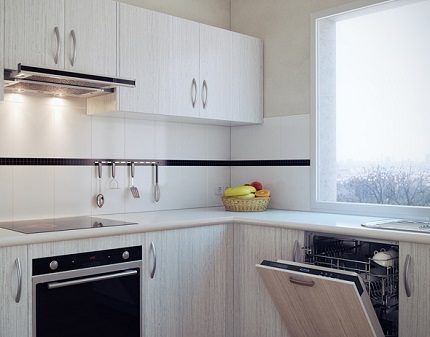
Calculating air exchange in accordance with sanitary standards is much easier to perform. Let's assume that in the house discussed above, two people permanently live and two more stay in the premises irregularly.
The calculation is performed separately for each room in accordance with the norm of 60 cubic meters per person for permanent residents and 20 cubic meters per hour for temporary visitors:
- Bedroom - 2 people * 60 = 120 cubic meters per hour;
- Office - 1 person * 60 = 60 cubic meters per hour;
- Living room 2 people*60 + 2 people*20 = 160 cubic meters per hour;
- Children's room 1 person * 60 = 60 cubic meters per hour.
Total by inflow — 400 cubic meters per hour.
There are no strict rules for the number of permanent and temporary inhabitants of a house; these numbers are determined based on the real situation and common sense.
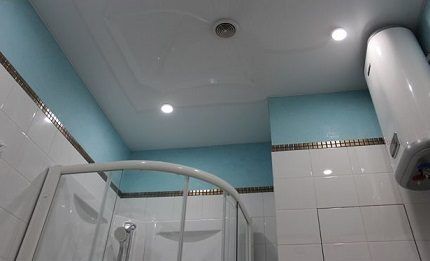
The exhaust is calculated according to the standards set out in the table above and increased to the total inflow indicator:
- Kitchen - 60 cubic meters. — 300 cubic meters/h;
- Bathroom - 9 cubic meters. — not less than 50 cubic meters/h;
- Bathroom - 12 cubic meters. — not less than 50 cubic meters/hour.
Total by hood: 400 cubic meters/h.
Increased air exchange for the kitchen and bathroom. Insufficient exhaust volume can be divided between all rooms in which the unit is installed. exhaust ventilation. Or increase this indicator for only one room, as was done when calculating by multiples.
In accordance with sanitary standards, air exchange is calculated in a similar way. Let's say the area of the house is 130 sq.m. Then the air exchange along the inflow should be 130 sq.m*3 cubic meters/hour = 390 cubic meters/hour.
It remains to distribute this volume among the exhaust hood rooms, for example, in this way:
- Kitchen - 60 cubic meters. — 290 cubic meters/h;
- Bathroom - 9 cubic meters. — not less than 50 cubic meters/h;
- Bathroom - 12 cubic meters. — not less than 50 cubic meters/hour.
Total by hood: 390 cubic meters/h.
Air exchange balance is one of the main indicators when designing ventilation systems. Further calculations are performed based on this information.
How to choose the cross-section of the air duct?
The ventilation system, as is known, can be ducted or ductless. In the first case, you need to choose the right channel cross-section.If a decision is made to install structures with a rectangular cross-section, then the ratio of its length and width should approach 3:1.
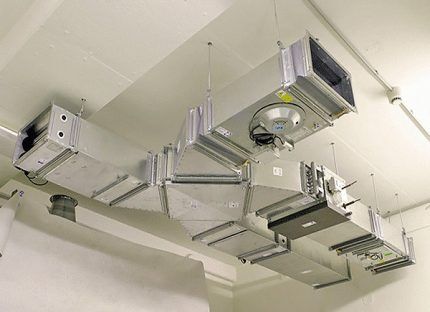
Standard speed of movement of air masses along the main ventilation duct should be about five meters per second, and on the branches - up to three meters per second. This will ensure the system operates with minimal noise. The speed of air movement largely depends on the cross-sectional area of the duct.
To select the dimensions of the structure, you can use special calculation tables. In such a table, you need to select the air exchange volume on the left, for example, 400 cubic meters per hour, and select the speed value at the top - five meters per second.
Then you need to find the intersection of the horizontal line for air exchange with the vertical line for speed.

From this intersection, draw a line down to a curve from which a suitable section can be determined. For a rectangular duct this will be the area, and for a round duct this will be the diameter in millimeters. First, calculations are made for the main air duct, and then for the branches.
Thus, calculations are made if only one exhaust duct is planned in the house. If it is intended to install several exhaust ducts, then the total volume of the exhaust duct must be divided by the number of ducts, and then calculations must be made according to the stated principle.
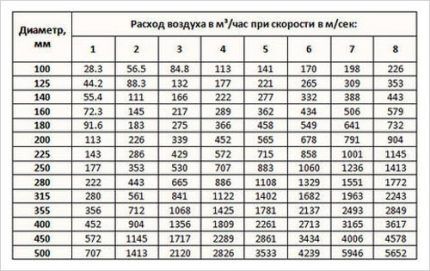
In addition, there are specialized calculation programs that can be used to perform such calculations. For apartments and residential buildings, such programs can be even more convenient, since they give a more accurate result.
Normal air exchange is influenced by such a phenomenon as reverse draft, the specifics of which and ways to combat it will familiarize you our recommended article.
Conclusions and useful video on the topic
Video #1. Useful information on the principles of operation of the ventilation system:
Video #2. Along with the exhaust air, heat also leaves the home. Calculations of heat losses associated with the operation of the ventilation system are clearly demonstrated here:
Correct calculation of ventilation is the basis for its successful functioning and the key to a favorable microclimate in a house or apartment. Knowledge of the basic parameters on which such calculations are based will allow not only to correctly design the ventilation system during construction, but also to adjust its condition if circumstances change.
Would you like to share your own experience in the calculation and construction of ventilation? Did you have any questions while reviewing the information? Found any flaws in the text? Please write comments in the block located under the text of the article.




I must say that I had a similar situation with ventilation in the kitchen. I also had to tinker with calculations, etc.But I would like to know: can ventilation somehow affect the temperature in the room? After all, there are situations when you need, for example, to expand the ventilation duct, but you still want to eat your food warm so that it doesn’t get colder.
Good afternoon, Ivan. If we are talking about natural ventilation, without equipped ventilation, then with closed windows and doors the air flow rate will be minimal, no matter how wide the channel is.
The size of the cross-section of the ventilation duct affects the maximum throughput. I don’t recommend expanding the channel for the reason “it needs to be expanded.” Decisions must be made clearly based on calculations.
I will give simple examples. Increased humidity in the house with correct ventilation calculations can be due to:
1. Violation of floor waterproofing technology. Moisture is drawn from the ground.
2. Insufficient wall thickness.
3. The tightness and slope insulation technology are broken.
4. Insufficient thermal insulation of the attic space.
Moisture condenses at the coldest point, which leads to mold/mildew. Thoughtlessly increasing the capacity of the ventilation system does not eliminate the original cause, but in most cases only makes it worse.
I'm so tired of dealing with this problem in my bathroom. No matter what I do, the windows still fog up and mold appears. It was necessary to calculate everything during construction. I realized that I couldn’t figure this out on my own.
Hello.You can calculate the dew point, carry out external insulation during the hot period when the walls are dry (at this time it is advisable not to use the bathtub), get rid of existing mold, and also install a ventilation system. In principle, it is quite possible.
Hello! We had the same problem. Mold was growing on the ceiling along the wall in the room and on the silicone putty on the plastic window. We didn't install the windows. We bought an apartment with existing windows. They removed the windows, and it was terrible. Almost no foam. Where they stuffed the newspaper, where they sealed it with cement, and where there were even holes.
They did everything according to science and put the window in place too. The mold was washed off with chemicals. Made repairs. The problem has disappeared. By the way, the windows also stopped fogging up. When windows are not airtight, there are drafts and cold bridges, then mold will grow and flourish.
Hello, dear specialists! In my apartment, namely in the living room, mold has formed in the corner opposite the windows, what should I do to get rid of mold!!!